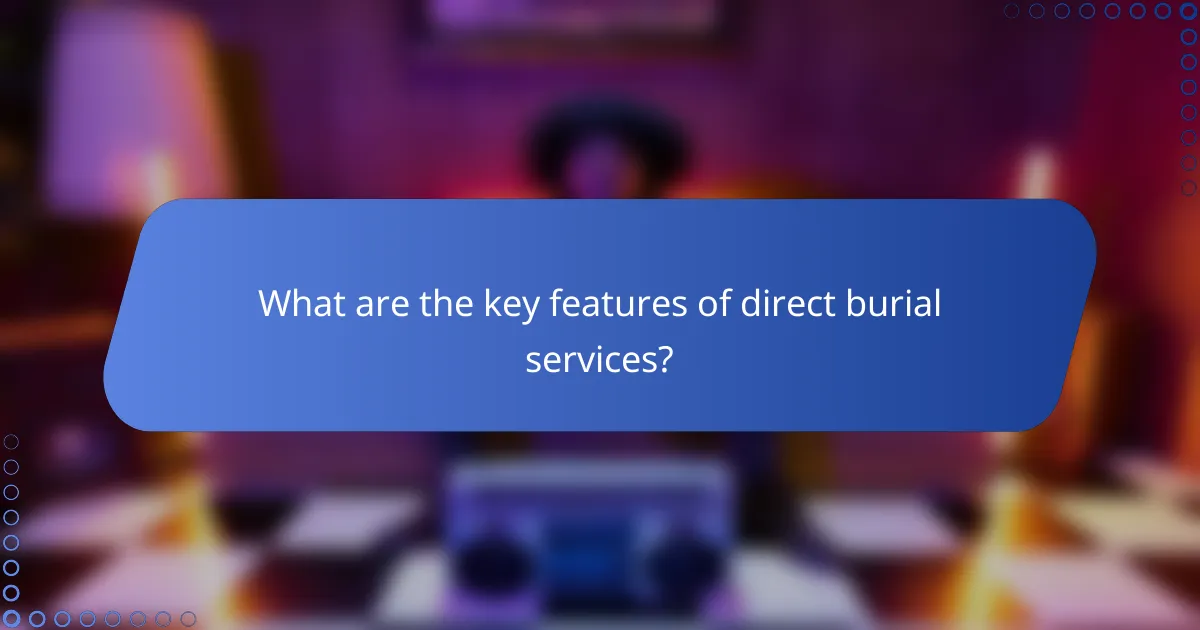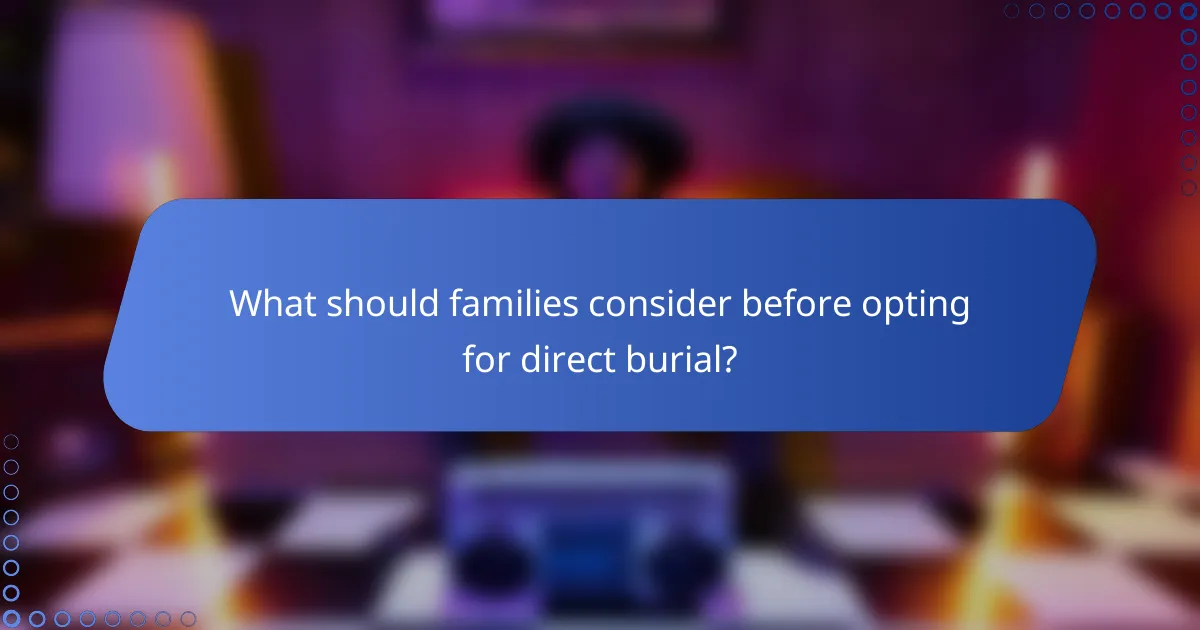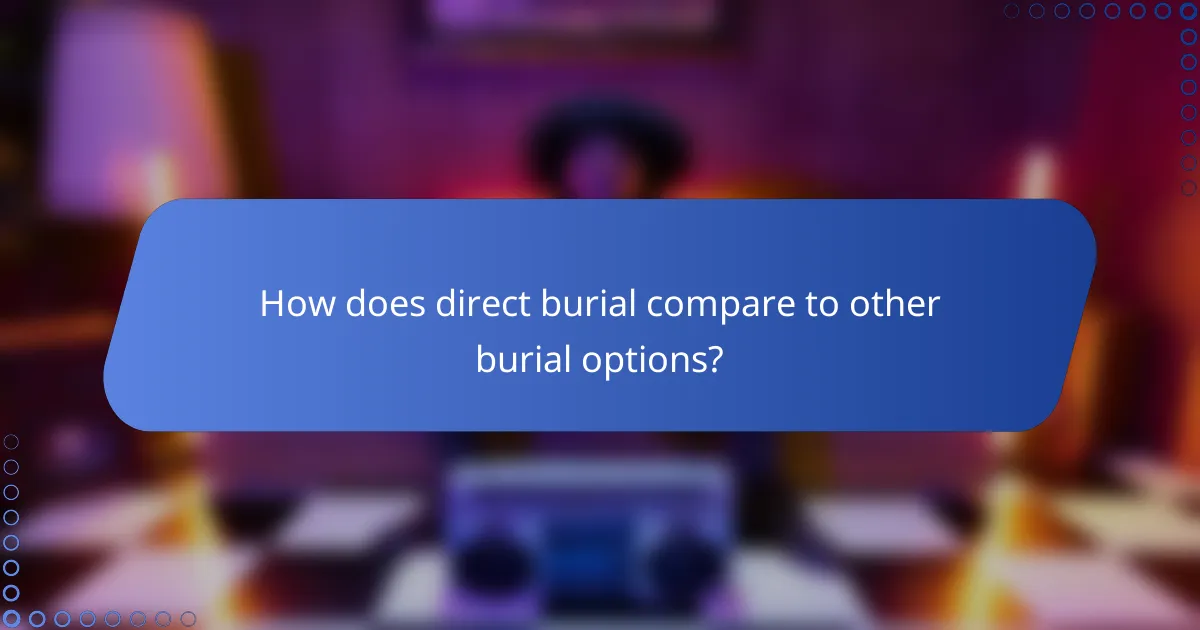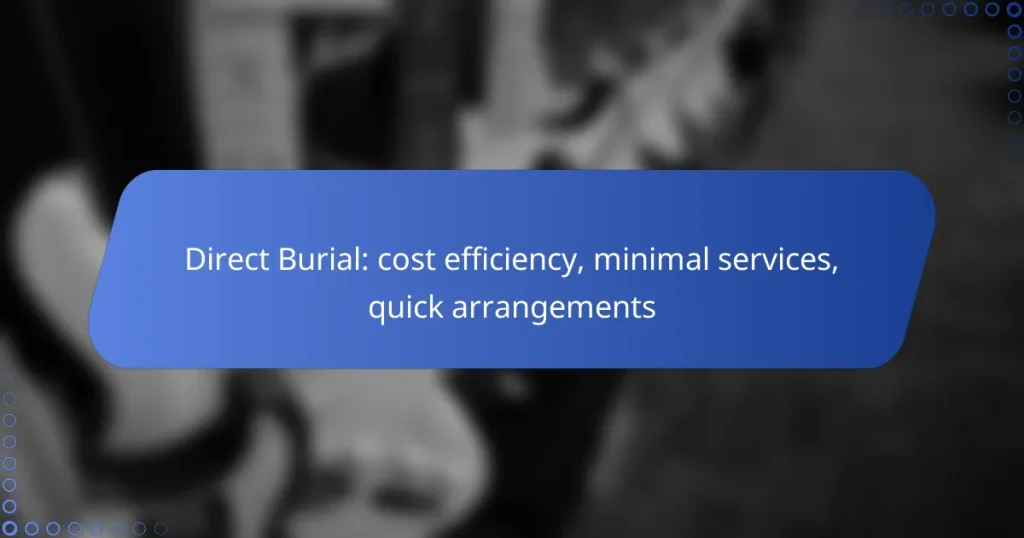Direct burial offers a cost-effective alternative to traditional funerals by significantly reducing expenses associated with viewing, embalming, and elaborate ceremonies. This approach prioritizes minimal service requirements and allows for quick arrangements, making it an efficient choice for families during a difficult time. With typical costs ranging from CAD 1,500 to CAD 4,000, direct burial provides a practical solution for those seeking simplicity and affordability in their burial options.

How does direct burial reduce funeral costs in Canada?
Direct burial significantly lowers funeral costs in Canada by minimizing the services and products typically associated with traditional burials. This approach eliminates many of the expenses related to viewing, embalming, and elaborate ceremonies, making it a more affordable option for families.
Lower service fees
Direct burial typically incurs lower service fees compared to traditional funerals. Families can avoid costs associated with funeral home services such as preparation, viewing, and memorial services. By opting for direct burial, families may save hundreds to thousands of Canadian dollars.
Many funeral homes offer packages specifically for direct burials, which can further reduce costs. It’s advisable to compare these packages to find the most economical option that meets your needs.
Minimal equipment requirements
Direct burial requires fewer resources and equipment than traditional burial methods. There is no need for caskets, vaults, or elaborate preparation equipment, which can significantly cut costs. Families can often choose a simple, biodegradable casket or even a shroud, which are more affordable alternatives.
Additionally, some cemeteries may have specific requirements for burial containers, so it’s important to check local regulations. Understanding these requirements can help families make informed choices that align with their budget.
Reduced transportation expenses
Transportation costs are often lower with direct burial since there is no need for transporting the deceased to a funeral home for preparation. Instead, the body can go directly to the burial site, reducing mileage and associated fees.
Families should also consider the location of the burial site in relation to their home. Choosing a nearby cemetery can further minimize transportation expenses, making direct burial a more cost-effective choice overall.

What are the key features of direct burial services?
Direct burial services are characterized by their cost efficiency, minimal service requirements, and expedited arrangements. These services allow families to handle the burial process without the need for elaborate ceremonies or extensive planning.
Simple arrangements
Direct burial services simplify the planning process by offering straightforward options. Families typically choose a basic casket and a burial plot, minimizing the need for additional services like viewings or memorials. This approach can significantly reduce both emotional stress and financial burden.
When selecting a direct burial service, consider contacting local funeral homes to compare their offerings. Many providers have packages that include essential services, making it easier to understand costs upfront.
Quick processing times
One of the main advantages of direct burial services is their quick processing times. Families can often complete arrangements within a few days, allowing for a timely burial. This is particularly beneficial for those who wish to avoid prolonged mourning periods.
To expedite the process, gather necessary documents such as the death certificate and identification beforehand. This preparation can help ensure that all required paperwork is in order, facilitating a smoother experience.
Limited service options
Direct burial services come with limited service options, which can be both an advantage and a drawback. While this simplicity can lead to lower costs, it may not meet the needs of families seeking a more personalized farewell. Understanding these limitations is crucial when making arrangements.
Consider discussing your preferences with the funeral provider to explore any available add-ons, such as memorial markers or graveside services. This can help you find a balance between simplicity and personalization within your budget.

What is the typical pricing for direct burial in Canada?
The typical pricing for direct burial in Canada generally ranges from CAD 1,500 to CAD 4,000. This option offers a cost-effective alternative to traditional burial, focusing on minimal services and quick arrangements.
Average cost range
The average cost for direct burial in Canada typically falls between CAD 1,500 and CAD 4,000. This price range includes basic services such as transportation of the body and the burial plot but excludes additional services like embalming or elaborate memorial services.
Costs can vary significantly based on location, cemetery fees, and any additional services chosen. For example, urban areas may have higher fees compared to rural locations.
Factors affecting pricing
Other considerations include any required permits, transportation fees, and the choice of a simple casket or container. Opting for minimal services will help keep costs down.
Comparison with traditional burial

What are the benefits of choosing direct burial?
Choosing direct burial offers cost efficiency, minimal services, and quick arrangements, making it a practical option for many families. This method typically involves fewer expenses and less planning, allowing for a straightforward process during a difficult time.
Environmental considerations
Direct burial is often seen as an environmentally friendly option. It typically requires less land use and fewer resources compared to traditional burial methods, which may involve elaborate caskets and vaults.
By opting for direct burial, families can choose biodegradable materials that minimize environmental impact. This approach aligns with sustainable practices, appealing to those concerned about ecological footprints.
Less emotional stress
Direct burial can significantly reduce emotional stress for grieving families. With fewer decisions to make and a streamlined process, families can focus on healing rather than planning elaborate ceremonies.
This simplicity allows families to bypass the complexities of traditional funerals, which can often be overwhelming. Direct burial provides a dignified option that respects the deceased while easing the burden on loved ones.
Faster closure for families
Families can achieve faster closure through direct burial, as arrangements can often be made quickly. This method eliminates lengthy planning and allows for a more immediate farewell.
For many, the ability to hold a simple service shortly after passing can facilitate the grieving process. Quick arrangements help families begin their healing journey without prolonged delays associated with traditional funerals.

What should families consider before opting for direct burial?
Families should consider several factors before choosing direct burial, including legal requirements, burial location, and personal preferences. This option typically involves fewer services and quicker arrangements, making it a cost-effective choice for many.
Legal requirements
Before proceeding with direct burial, families must be aware of the legal requirements in their area. This often includes obtaining a death certificate and ensuring that the burial site complies with local regulations. In the United States, for example, each state has specific laws governing burial practices, which can vary significantly.
It’s advisable to consult with a funeral director or local authorities to understand the necessary documentation and permits needed for direct burial. Failing to meet these requirements can lead to delays or complications during the burial process.
Location of burial
The location of the burial is a crucial consideration for families opting for direct burial. Families should choose a site that is legally designated for burials, such as a cemetery or a family plot. Accessibility and proximity to family members can also influence this decision.
Additionally, families may want to consider the long-term maintenance of the burial site. Some cemeteries offer perpetual care, while others may require families to manage upkeep, which could affect their choice of location.
Family preferences
Family preferences play a significant role in the decision to pursue direct burial. Some families may prioritize simplicity and cost savings, while others might have specific traditions or rituals they wish to incorporate. Understanding these preferences can help guide the decision-making process.
It’s beneficial for families to discuss their values and expectations openly. This conversation can clarify what is most important, whether it’s a straightforward burial or incorporating certain elements that honor the deceased’s life. Engaging in this dialogue early can lead to a smoother planning experience.

How does direct burial compare to other burial options?
Direct burial is often more cost-effective and quicker than traditional burial or cremation. It involves minimal services, allowing families to focus on essential arrangements without the added expenses of elaborate ceremonies.
Direct burial vs. traditional burial
Direct burial typically costs significantly less than traditional burial, which often includes a viewing, embalming, and a formal service. While traditional burial can range from several thousand to over ten thousand USD, direct burial may only require a few thousand USD, depending on the cemetery and services selected.
In a traditional burial, families usually have to coordinate multiple services, which can prolong the process. Direct burial streamlines this by eliminating unnecessary steps, allowing for a faster and simpler arrangement.
Direct burial vs. cremation
Direct burial and cremation serve different preferences, but both can be cost-effective. Cremation costs can vary widely, often ranging from low hundreds to a few thousand USD, depending on the services chosen, such as urn selection or memorial services.
While direct burial involves interring the body in the ground, cremation reduces the body to ashes, which can be kept, scattered, or buried. Families should consider their emotional needs and budget when choosing between these options, as both provide a straightforward approach to handling remains.


